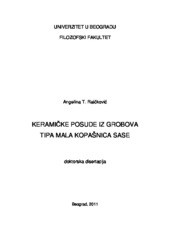Keramičke posude iz grobova tipa Mala Kopašnica Sase
Ceramic vessels in graves of the Mala Kopašnica - Sase type
| dc.contributor.advisor | Vujović, Miroslav | |
| dc.contributor.other | Vuković, Jasna | |
| dc.contributor.other | Korać, Miomir | |
| dc.creator | Raičković, Angelina T. | |
| dc.date.accessioned | 2016-01-05T12:52:39Z | |
| dc.date.available | 2016-01-05T12:52:39Z | |
| dc.date.available | 2020-07-03T09:57:53Z | |
| dc.date.issued | 2012-12-18 | |
| dc.identifier.uri | http://eteze.bg.ac.rs/application/showtheses?thesesId=487 | |
| dc.identifier.uri | https://nardus.mpn.gov.rs/handle/123456789/3246 | |
| dc.identifier.uri | https://fedorabg.bg.ac.rs/fedora/get/o:6400/bdef:Content/download | |
| dc.identifier.uri | http://vbs.rs/scripts/cobiss?command=DISPLAY&base=70036&RID=522262423 | |
| dc.description.abstract | Grobovi ovog tipa dobili su naziv po eponimnim lokalitetima Mala Kopašnica i Sase. Postoje tri varijante ove vrste grobova spaljenih pokojnika od kojih se na nekropolama najčešće javljaju dve: jednostavne rake i etažni grobovi. Zajednička karakteristika im je zapečenost zidova. Kod etažnih se javlja nekoliko varijanti konstrukcije i pokrivanja donjeg etaža. Za sve tipove grobova karakteristično je da su neki prilozi goreli zajedno sa pokojnikom, dok su drugi prilagani naknadno. Najbrojnije priloge čine keramički proizvodi, u prvom redu posude i žižci. Odlagani su ili u donji etaž, ili po uglovima gornjeg etaža, a ponekad i po sredini strana. Broj priloga u grobu variva. Nekad su bez priloga, nekad imaju žižak,a vrlo brojno se uz njega nalaze i posude. Njihov broj se kreće od 1 do 25, a najčešće je u pitanju tri posude. Od oblika najbrojnije se javljaju kračazi a brojem varijanti najzastupljenije su zdele. Posude su na svim nekropolama opredeljene kao proizvodi lokalnih radionica. Importnih primeraka je malo i u pitanju su najčešće oblici zdela. Posude su najvećim delom rađene od srednje prečišćene gline crvene boje pečenja i spoljne površine bojene tonovima crvene do mrke boje. Konstatovano je da se u ovoj vrsti grobova javlja 11 formi posuda koje su razvrstane u preko 220 tipova. Antropološkim analizama nije se mogla potvrditi teorija da je broj i oblik posuda u vezi sa polom pokojnika. Najbrojniji nalazi potiču sa teritorije provincije Gornje Mezije, a brojno se javljaju u jugoistočnom delu Panonije, kao i u delovima Dakije i Trakije i to u vremenskom trajanju od sredine prvog do kraja trećeg veka. | sr |
| dc.description.abstract | The graves of this Type got their names after eponim localities Mala Kopasnica and Sase. There are three types of these graves with burned bodies among which two of them are most distinguished: simple and duble-levelled grave pits. There common characteristic is the burned sides of the walls. At duble-levelled pits there are several types of construction as well as covering of the lower part of the grave pit. All types of the graves are characterized by the fact that some inventories were burned with the body while the other ones were put later. The most numerous are ceramic products, among which vessels and oil-lamps are at the first place. They were put either into the lower grave pit or in to the corners of the upper grave pit, and sometimes in the middle sides. The number of grave inventories in changeable. Sometimes they are without any inventories, sometimes they have only an oil-lamp, and most often beside an oil-lamp there are vessels as well. The number of vessels is from 1 to 25, most often there are three vessels. Jags represent the most numerous number of forms, and the bowls are represented in the most numerous types. At all necropolis, the vessels are produced as a typical product of local workshops. There are few imported findings and they are usually in the forms of bowls. Most bowls were made from well-levigated clay and fired to red. The surfaces are untreated or painted in red to dark brown. It is estimated that in this type of graves 11 forms of vessels are classified and divided into more tham 220 types. It wasn’t able to confirm, by anthropological analyses, the theory that number of vessels alongside with their forms were connected with gender of body. The most numerous findings are originated from the province Moesia Superior, and there are lot of them in the southeastern part of Pannonia, as well as in parts of Dacia and Tracia, from the middle of I century till and of the III century | en |
| dc.format | application/pdf | |
| dc.language | sr | |
| dc.publisher | Универзитет у Београду, Филозофски факултет | sr |
| dc.rights | openAccess | en |
| dc.rights.uri | https://creativecommons.org/licenses/by-nc/4.0/ | |
| dc.source | Универзитет у Београду | sr |
| dc.subject | nekropola | sr |
| dc.subject | necropolis | en |
| dc.subject | grob | sr |
| dc.subject | grobni prilog | sr |
| dc.subject | funkcija | sr |
| dc.subject | keramička posuda | sr |
| dc.subject | krčag | sr |
| dc.subject | zdela | sr |
| dc.subject | lonac | sr |
| dc.subject | datovanje | sr |
| dc.subject | Munssel | sr |
| dc.subject | grave | en |
| dc.subject | inventories | en |
| dc.subject | function | en |
| dc.subject | ceramic vessel | en |
| dc.subject | jags | en |
| dc.subject | bowl | en |
| dc.subject | pot | en |
| dc.subject | dating | en |
| dc.subject | Munssel | en |
| dc.title | Keramičke posude iz grobova tipa Mala Kopašnica Sase | sr |
| dc.title | Ceramic vessels in graves of the Mala Kopašnica - Sase type | en |
| dc.type | doctoralThesis | en |
| dc.rights.license | BY-NC | |
| dcterms.abstract | Вујовић, Мирослав; Вуковић, Јасна; Кораћ, Миомир; Раичковић, Aнгелина Т.; Керамичке посуде из гробова типа Мала Копашница Сасе; Керамичке посуде из гробова типа Мала Копашница Сасе; | |
| dc.identifier.fulltext | https://nardus.mpn.gov.rs/bitstream/id/26382/Disertacija.pdf | |
| dc.identifier.fulltext | http://nardus.mpn.gov.rs/bitstream/id/26382/Disertacija.pdf | |
| dc.identifier.doi | 10.2298/bg20121218raickovic | |
| dc.identifier.rcub | https://hdl.handle.net/21.15107/rcub_nardus_3246 |


